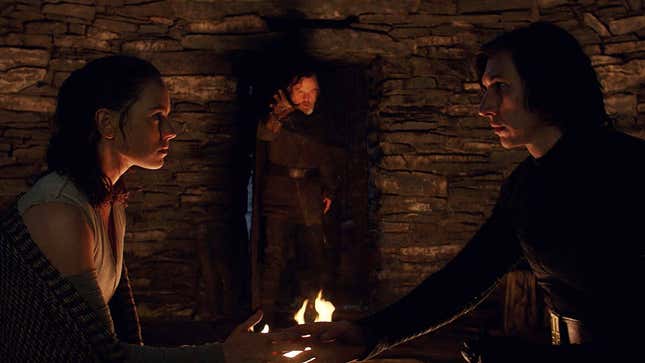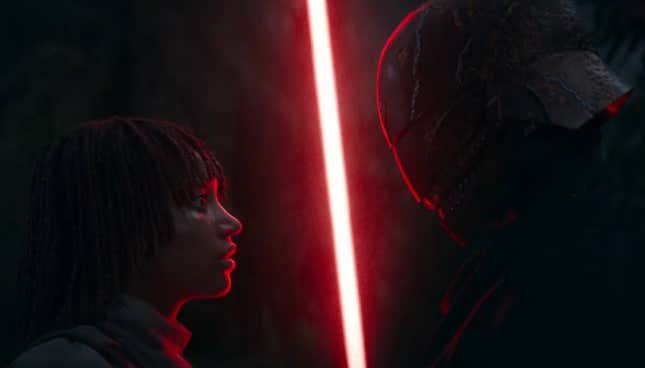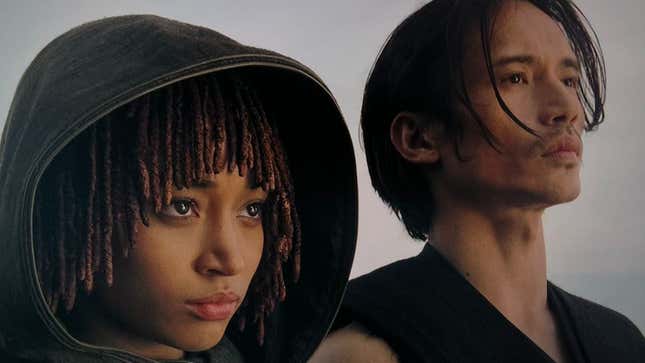The Star Wars fandom is a fraught, fervent place. In the modern age, online communities rallying around franchises are often composed of numerous splinter groups, and Star Wars is no exception—it’s got far-right reactionaries, original trilogy boomers, millennial prequel loyalists, Gen Z animated series lovers, and, of course, Reylos. It’s that last group—fans who ship characters Kylo Ren and Rey Skywalker of the sequel trilogy, and who are often women or queer folks—that have felt ostracized by other Star Wars fans in the years since 2019’s The Rise of Skywalker, and are just now feeling justified thanks to The Acolyte.
Sparks undeniably flew between Kylo and Rey in The Last Jedi, only to be briefly fanned and then snuffed out in the almost universally panned sequel, leaving Reylos convinced there was no love left in the Star Wars universe, and no love for them, either. But then came The Acolyte, the latest Disney+ Star Wars series, and its season finale—and with it, vindication for Reylos.
Former Jedi Padawan Osha (Amandla Stenberg) and dark side practitioner Qimir (Manny Jacinto) end up together, holding hands, staring out at the horizon. Romance (and specifically the kind of enemies-to-lovers romance that fanfic writers love) is back on the cantina menu, so I spoke to several self-proclaimed Reylos via email to learn how The Acolyte speaks directly to them.

The rise and fall of Reylos
“The two holding hands looking off into the sunset, rather than ending up alone. I think for a lot of Reylos, that’s really healing,” fantasy author Alex Kennington tells me via email. “It’s really nice to see [The Acolyte showrunner] Leslye Headland not shying away from the romance in interviews when it seemed like during the sequel trilogy the creators tried to be more vague and that only fueled the internet backlash.”
For many Reylos, the sequel trilogy’s failure to center the burgeoning romance between Kylo and Rey pointed to a franchise-wide reluctance to cater to the more feminine side of the fandom. Whereas the prequels put Anakin Skywalker and Padme Amidala’s love at their center, the conclusion to the sequel trilogy shied away from a full-blown romance, choosing instead to focus on Rey’s newly revealed connection to Emperor Palpatine, even though we learned Kylo and Rey are a “dyad,” a duo that shares a similar spark of the Force. The two share a single kiss near the end of TRoS, immediately after which Kylo dies.
“[The Rise of Skywalker] was probably the only time I have seen two characters kiss on screen and then seen fans instead of saying, ‘oh okay…it was meant to be romantic,’ you had people going, ‘oh it was a platonic kiss.’ The time after TRoS was truly wild,” author Ria Parisi explained via email. “The bad [part of their relationship] came from the final execution and unfortunate backlash. It’s very disappointing and sad to set up two characters who are supposed to be one half of each other and then leave one of them alone.”
“Where Reylo suffered the most was in the disconnect of ideas across the three films,” content creator Sawyer Markham wrote, referencing how the first and last films were made by J.J. Abrams while the middle was done by Rian Johnson, a decision many feel led to bizarre tonal shifts throughout the trilogy. And when the Reylos took to the internet to lament what they felt was a squandered on-screen romance, they faced widespread backlash. It’s important to note that, like all corners of Star Wars fandom, there was a sect of Reylos who exhibited some fairly virulent racism, swapping Kylo in for John Boyega’s Finn in fan art and fan-fic. But much of the anti-Reylo backlash felt rooted more in old-school misogyny than anything else.
“I think any online fandom or fandom subsect that is largely made up of people who aren’t cishet white men is inevitably treated badly. Reylos loved and connected with The Last Jedi in particular, whilst another small but very loud part of the fandom didn’t,” writer and director Laurie Kirwan-Ashman told me via email. “This coincided with the Star Wars fandom being infiltrated by the far-right off the back of Comicsgate, which then turned into a YouTube culture wars money-making grift that has created its own toxic cult.”
In the years since The Last Jedi and The Rise of Skywalker, Disney’s Star Wars stories have mostly avoided romance, but when Headland took the helm for The Acolyte, she made it clear that she wasn’t going to shy away from longing glances and grazing hands.

Enemies to lovers, for real this time
In stark contrast to any other official Star Wars media, The Acolyte wears its ship on its sleeve. “We went from Kylo taking off his shirt and people not getting it was meant to be the set up for a romantic relationship to this show saying, ‘Fine you didn’t get it with that? We’ll make [Qimir] fully nude’,” said Kennington. “And seeing the fans come together again in a way I haven’t seen since right after The Last Jedi, it just feels amazing.”
Not only did the series unabashedly lean into Manny Jacinto’s sex appeal, giving us what may be the first Star Wars character who’s canonically naked on-screen, but it subverted typical series tropes—Osha, raised by the Jedi, turns to the dark side, drawn there by her connection to Qimir. It’s the kind of romance plot Reylos have been dreaming of for years. “I read an interview that Leslye Headland did where she discussed how past characters talked about being seduced by the Dark Side and how we’d never actually seen that onscreen so she decided to give it to us—and she did!” author Sariah Wilson said over email.
“I still have to kind of pinch myself, like, am I really seeing a Star Wars show where a young woman abandons the institutional ‘We Have All The Answers’ club in favor of something more nuanced and complex, and is celebrated in the narrative for it, and gets to hold hands with the guy she had a connection with and look at the sunset?” Carrie, an early childhood professional, wondered.
And it’s not just about the broad strokes of a corruption courtship, it’s the manner in which that courtship is portrayed, with the kind of soft, sensual femininity that we almost never see in Star Wars. “It’s so slick, it’s so intentional, it’s so hot, it’s everything Star Wars could have been for the last seven years if the (overblown) reaction (from a loud minority of affirmative fans joined by right wing grifters) to The Last Jedi didn’t spook the higher-ups so badly,” said comic artist Para Caspari.
In The Acolyte episode 6, Jacinto’s Qimir offers a not-so-subtle thesis for the “Oshamir” romance: “Below the surface of consciousness are powerful emotions—anger, fear, loss…desire.” Qimir seduces Osha, showing her that the Jedi way is draconian and severe, and even though she resists him at first, once she realizes the mistakes the Jedi made and how they resulted in the death of her mother, she sees that there’s much more nuance than they’d like her to believe. And so, she chooses Qimir, and the Dark Side.
“On the surface level, they’re obviously both incredibly beautiful people but, as with Reylo, what has really sparked so much investment in them is their dynamic: the push/pull tension, the way they surprise and challenge each other, the roles they’re playing and what they offer for each other’s character development,” explained Kirwan-Ashman. “There was a lot of really fun sexual subtext in TLJ…but it’s such a joy to have it be so explicitly explored in The Acolyte, and for the show to be so clearly interested in how seduction and desire play into the wider themes.”

Vindicated, swear I knew it all along
It’s unclear if The Acolyte will get a second season, due in large part to the gargantuan cost Disney incurred making it (Forbes estimates it at about $180M for the season) and preliminary ratings that suggest it performed poorly compared to other Star Wars shows (so did Andor, by the way). But right now, Reylos are riding high after the recent finale—dare I say, they’re feeling vindicated—largely because Headland has been so open in discussing her vision for the series, and how Osha and Qimir’s dynamic is at its core.
“Leslye [Headland] wasn’t afraid to take risks in setting up the romantic undertones for these characters, and when asked about it in interviews she confirmed that that was her intent, which is something that was markedly missing from the Reylo era,” explained Markham. Rather than squabbling over subtext, Acolyte fans have concrete proof that this is a series about romance, and about blurring the lines between good and evil—as many pointed out after the season finale, Jedi Master Sol (Lee Jung-jae) maintained a lie for over a decade, insisting that Osha’s sister Mae was the reason why their entire witch coven perished. Qimir, on the other hand, gives Osha all the information she needed to make an informed decision, and space to ponder her future. By the end of the finale, she turns to him, hand outstretched, and chooses to train alongside him. To Reylos, this is a revelation.
“That’s why I think Acolyte is hitting such a chord with so many Reylo shippers: here’s a complex young woman who struggles with her darkness in a very real-feeling way onscreen, who can’t maintain her cognitive dissonance anymore, and who is learning that anger and fear and yes, desire, are all completely fine and normal emotions to feel and to harness in life,” Carrie pointed out.
Caspari takes it a step further, saying The Acolyte is “not just vindication but it specifically feels like a response to the Sequels along the lines of my aforementioned criticisms. It feels like Headland saying, ‘that sucked, here’s how I’d have done it’.” She continued, “Of course, if you’re a Reylo it feels like you’re finally free after being gaslit for a decade…of being told by both antis and affirmative fans alike that we were being weird, reading too much into it, projecting our own immoral fantasies, etc. it means a lot.”
Oshamir is also bittersweet for many Reylos, who wish they would have seen this kind of romance play out on the big screen. “In one way it’s a win because it feels like we’re finally allowing for women to be messy and complex in their characterization,” pointed out Carrie. “But on the other hand there’s definitely some bitterness because if Osha and Qimir holding hands and staring off into the sunset together was fine, why couldn’t we have had anything like that in TROS?”
“It also feels vindicating in the sense of being a show that includes and represents people who have been historically marginalized, both in terms of on-screen depiction in Star Wars and beyond,” said Kirwin-Ashman. “The Acolyte is created by a lesbian and all the main characters are played by women, non-binary, queer people and people of color.”
And though that may be what caused bad actors to review-bomb it and reactionary Star Wars YouTubers to declare The Acolyte dead in the water, Reylos have a very different outlook. As Kirwin-Ashman pointed out, “it really feels like it’s welcoming a new generation of the fandom as well as those who have loved Star Wars for a long time but have often felt in the past like Star Wars didn’t love them back.”









